


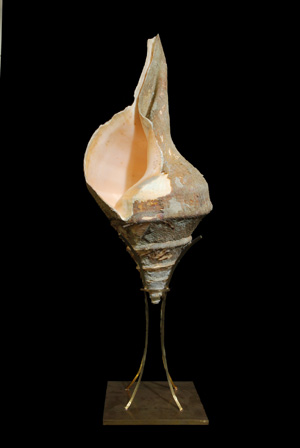
アラフラオオニシ
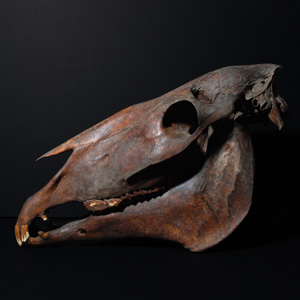
ウマ頭骨
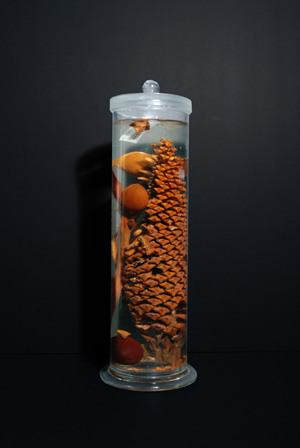
ナンヨウソテツ
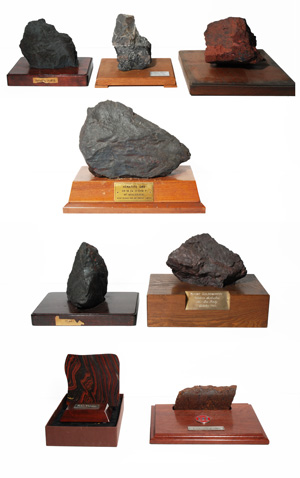
世界の高品位鉄鉱石
1段目、左から右へ
1.インド・バイラデイラ鉱山の赤鉄鉱
2.スウェーデン・キルナ鉱山の磁鉄鉱
3.南アフリカ・タバジンビ鉱山のカンガ
2段目
4.オーストラリア・ホエイルバック 鉱山の赤鉄鉱
3段目、左から右へ
5.ブラジル・アグアスクララス鉱山の 赤鉄鉱
6.オーストラリア・ゴルズワージー 鉱山の赤鉄鉱
4段目、左から右へ
7.オーストラリア・ゴルズワージー 鉱山の赤鉄鉱
8.オーストラリア・ヤンデイクージナ 鉱山の褐鉄鉱

モバイルミュージアム(赤坂インターシティ)
展示標本 (2013.2.4〜2013.8.2)
小ケース1:アラフラオオニシ
産地:インドネシア。世界最大かつ最も重い殻を持つ巻貝で、殻高は通常は50cm前後、大形個体では80cm以上に達する。オーストラリア北部、パプアニューギニア、インドネシアに分布し、潮帯間から潮下帯上部の浅海の砂底に生息する。殻は黄白色であるが、殻の表面は褐色の有機質の殻皮を被っている。肉食性で多毛類を食べる。食性以外の生態はほとんど調べられておらず、寿命は不明。オーストラリアでは保護されており、国外に持ち出すことは出来ない。(標本番号 130110-S-1)
Syrinx aruanus (Linnaeus, 1758)
Locality: Indonesia. This is the largest and heaviest marine snail of the world. The shell height is normally around 50 cm, but exceptionally large specimens attain more than 80 cm. The geographic distribution is restricted to the northern Australia, Papua New Guinea and Indonesia, and the habitat is sandy bottoms from the intertidal to shallow subtidal zones. The shell is pale yellow in color, and its surface is covered by brownish organic membrane. Living animals are carnivorous and feed on polychaetes, but little is known about ecology and longevity. This species is protected, and exportation is prohibited in Australia. Registration number 130110-S-1
小ケース2:ウマ頭骨
年代未詳 乾燥標本 長450幅200高308。ウマは草原を駆け抜けることに特化した生物である。ウマが進化した地域は北米であるが、ユーラシアに分散した後、北米では氷河期に絶滅した。我々の使役するウマは中央アジアの原種を品種改良したものだ。ウシ科の動物と異なり、上顎にも頑丈な門歯を持つ。
Skull of horse (Equus caballus)
Date unknown Dried specimen H450 W200 H308.
Horse shows a unique adaptation to run about flat terrains. They had evolved in America, but extinct in that continent when they faced on glacier age after dispersed to Eurasia. All domestic variants of horse had generated from a wild species distributed in central Asia. They have robust incisor, or front teeth on maxilla unlike deer, cattle or goat.
小ケース3:ナンヨウソテツ
椿や蘭の研究で著名だった津山尚博士が、1939年にミクロネシアのヤップ島で採集したソテツ類の標本。松毬の様に見える小胞子嚢穂(雄の球花)と、球状の発達途中の種子を持つ大胞子葉(雌の球花の一部)。本種の種子は海流により散布され、インドから南太平洋諸島にかけての広い範囲に分布する。木の高さは7m、幹の直径は45cmに成長し、全長2mに達する葉をつける。ソテツ属は雌雄異株で、東南アジアを中心に熱帯・亜熱帯に約100種が知られる。本属の植物は毒素のホルムアルデヒドを含むが、飢饉のときには種子や幹を水にさらして採ったデンプンが利用され、救荒植物としての役割も果たしていた。「ソテツ(蘇鉄)」の名は、鉄を幹に打ち込むと元気になるという伝承に由来する。19世紀の終わりに、帝国大学農科大学の池野成一郎はソテツの精子を発見した。この発見は、同大の平瀬作五郎によるイチョウの精子発見とともに、種子植物の進化上重要な意味を持ち、学界の発展に大きく貢献した。
Cycas rumphii Miq. (Cycadaceae), Yap Island, September 1939
This specimen of Cycas rumphii was collected on Yap Island, Micronesia, by Dr. Takasi Tuyama, who was famous for his studies on camellias and orchids. The cone-shaped specimen is a microsporocarp (male cone), and the others with developing seeds are megasporophylls (part of a female cone). Because its seeds can be dispersed by ocean currents, Cycas rumphii occurs widely in coastal areas from India to the islands of the South Pacific. The branched trunk can reach 7 m tall and 45 cm across, with mature leaves up to 2 m long. All species of Cycas, numbering around 100, are dioecious (male and female reproductive structures on different individuals), and are mainly distributed in Southeast Asia and the islands of the South Pacific. Theplants contain formaldehyde, a toxic compound, but in time of famine, people have eaten the seeds and stems after detoxification by soaking them in water. It has been said that the Japanese name “So-Tetsu” comes from the belief that plants of Cycas become vigorous after iron nails are driven into their trunk. In the end of the nineteenth century, Dr. Seiichiro Ikeno at the Imperial University found swimming sperm in a plant of Cycas. This monumental discovery, along with the previous finding of motile sperm in Ginkgo by Dr. Sakugoro Hirase of the same university, was a major contribution to our knowledge of the evolution of seed plants.
中ケース:世界の高品位鉄鉱石
製鉄の原料となる鉄鉱石は世界中で産出されるが、鉄含有量の多い高品位のものは極めて限られる。ここに示す高品位鉄鉱石には最高で約70%という極めて高い鉄含有率を示すが、これは標準的な鉄鉱石の鉄含有率を大きく上回っている(鉄鉱石として広く使われている縞状鉄鉱層であっても、平均的な鉄含有率は30%程度である)。1. インド・バイラデイラ鉱山の赤鉄鉱 (IO1452)、2. 欧州最大の鉱床であるスウェーデン・キルナ鉱山の磁鉄鉱 (IO2600)、3. 南アフリカ・タバジンビ鉱山のカンガ (IO1716)、4. 西オーストラリア最大級の高品位鉱床で、高度成長期の主輸入先でもあったホエイルバック鉱山の赤鉄鉱 (IO1037)、5. ブラジル・アグアスクララス鉱山の赤鉄鉱 (IO1243)、6 (IO1010). および 7 (IO1014). オーストラリア・ゴルズワージー鉱山の赤鉄鉱、8. オーストラリア・ヤンデイクージナ鉱山の褐鉄鉱 (IO1015)。
High-grade iron ores
Iron-rich rocks can be commonly found in the world, however, high-grades (or high Fe-concentration) ores are produced only at limited locations. Iron ores shown here have quite high iron-concentrations up to 70%, which is significantly higher than those of standard ores (the concentrations of Iron in banded iron formations are in average about 30%). 1. Hematite from Bairadila, India (IO1452), 2. Magnetite from Kiruna, Sweden (IO2600), 3. Canga from Thabazimbi, South Africa (IO1716), 4. Hematite from Mt. Whaleback, Australia (IO1037), 5. Hematite from Aguas Claras, Brazil (IO1243), 6 (IO1010). and 7 (IO1014). Hematite from Mt. Golds Worthy, Australia, 8. Goethite from Yandicoogina, Australia (IO1015).
解説文執筆
佐々木猛智 (本館准教授、動物分類学、古生物学)
松原 始 (本館特任助教、動物行動学)
郄山 浩司 (本館特任助教、植物系統進化学)
宮本 英昭 (本館准教授、固体惑星科学)
写真撮影
松本 文夫 (本館特任准教授、建築学)
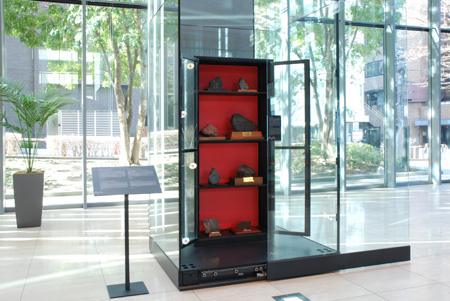
モバイルミュージアムの展示(世界の高品位鉄鉱石)
他の展示期間の展示物
2007年1月〜2007年7月
2007年7月〜2008年2月
2008年2月〜2008年8月
2008年8月〜2009年2月
2009年2月〜2009年7月
2009年8月〜2010年1月
2010年2月〜2010年7月
2010年8月〜2011年1月
2011年1月〜2011年7月
2011年8月〜2012年1月
2012年1月〜2012年7月
2012年8月〜2013年2月
2013年2月〜2013年8月
2013年8月〜2014年1月
2014年2月〜2014年11月
2014年11月〜2015年7月
2015年8月〜2016年1月
2016年2月〜2016年7月
今までのトップページの連続スライドショー
新日鉄興和不動産本社におけるモバイルミュージアム(非公開)
ページの先頭に戻る